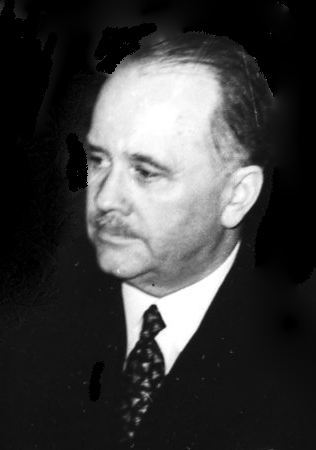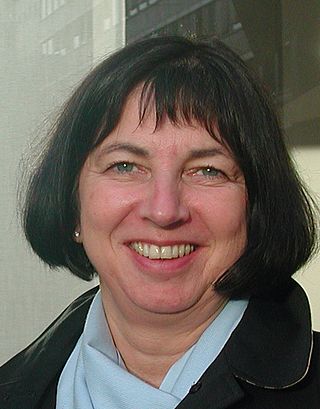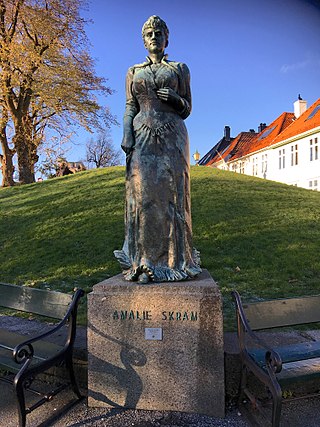
Aetat (short for Norwegian : Arbeidsmarkedsetaten) was a Norwegian government agency responsible for battling unemployment.

Aetat (short for Norwegian : Arbeidsmarkedsetaten) was a Norwegian government agency responsible for battling unemployment.
It had its roots in the Directorate of Labour (Norwegian : Arbeidsdirektoratet), which was founded in 1945. Its purpose was to "prevent and remedy" unemployment in the Norwegian society. The name Aetat was taken into use in 2000, when the directorate was reorganized. Aetat had eighteen county offices, several local offices, and other branches, whereas the directorate remained the core of the agency. The leader of the directorate was called the "director of labour" (Norwegian : arbeidsdirektør). The agency was subordinate to the Ministry of Government Administration. [1] [2] [3] [4]
In 2005 the Parliament of Norway agreed to abolish Aetat as well as the National Insurance Service, with effect from 2006. A new organization was created in their place, the Norwegian Labour and Welfare Administration (Norwegian : Arbeids- og velferdsforvaltningen, NAV) which consists of the state-run Norwegian Labour and Welfare Service (Norwegian : Arbeids- og velferdsetaten) and certain parts of the municipal social services, and has a broader responsibility for welfare. The reform that created NAV is not completed yet. [1] [5]

Erling Sandberg was a Norwegian banker and politician.

Sigrun Elisabeth Vågeng is a Norwegian public sector official. From 2015 to 2020 she was director of the Norwegian Labour and Welfare Administration.
Lars Wilhelmsen is a Norwegian civil servant.
Theodor "Ted" Hanisch is a Norwegian sociologist, civil servant and politician for the Labour Party.

Torolf Elster was a Norwegian newspaper and radio journalist, magazine editor, novelist, crime fiction writer and writer of short stories. He was Director-General of the Norwegian Broadcasting Corporation (NRK) from 1972 to 1981.
Christian A. R. Christensen was a Norwegian newspaper editor. He is known for his work in the Norwegian resistance movement, as editor of Verdens Gang and as a historical writer. He also helped shape the Ethical Code of Practice for the Norwegian Press.
Sverre Mitsem (1907–2004) was a Norwegian journalist, newspaper editor and article writer. He is known as editor-in-chief of Tønsbergs Blad from 1954 to 1977 and for the column "SORRY" in Aftenposten, which he wrote from 1946 to 1996.
Oskar Hasselknippe was a Norwegian newspaper editor. He is known for his work in the Norwegian resistance movement and as editor of Verdens Gang during its swift ascent among Norwegian newspapers.

LO Stat is one of two bargaining structures within the Norwegian Confederation of Trade Unions (LO). LO Stat is the counterpart in negotiations over state employees' wages and conditions with the government and the employer's organisation, Spekter.

Johan Christian Schreiner was a Norwegian historian. He was a professor at the University of Oslo, and his speciality was the Middle Ages.

Trygve Friis Bull was a Norwegian lecturer and politician. He was a member of Mot Dag in the 1920s and 1930s, and contributed to the magazines Mot Dag, Clarté and Kontakt. During World War II he was imprisoned by the Germans, and incarcerated at the Grini and Sachsenhausen concentration camps. He was a politician for the Labour Party, a deputy representative to the Storting from 1957 to 1969, and later a politician for the Socialist Left Party. He was a member of the committee Norsk Språknemnd from its establishment in 1952 until 1972, and Norsk språkråd from 1972 to 1981.

Frode Rinnan was a Norwegian architect and politician for the Labour Party.

Beate Gangås is a Norwegian police officer and civil servant. She is currently the director of the Norwegian Police Security Service since 2022. She previously served as the Oslo Chief of Police from 2019 to 2022.

The Norwegian Labour and Welfare Administration is the current Norwegian public welfare agency, which consists of the state Labour and Welfare Service as well as municipal welfare agencies. It is responsible for a third of the state budget of Norway, administering programs such as unemployment benefits, sickness benefits, pensions, child benefits, qualification programme, temporary accommodation, health services, and more. In 2022 the agency had approximately 22,000 employees including approximately 15,500 employed by the state, and approximately 6,500 employed by the municipalities. Its head is the Labour and Welfare Director, currently Hans Christian Holte, who is appointed by the government.

The National Insurance Service was a Norwegian government agency responsible for social security.

Maja Refsum was a Norwegian sculptor and teacher.
Isak Martinius Skaugen, was a Norwegian businessperson.

Ulla-Førre is a hydropower complex in Southern Norway. It is situated along the borders of the municipalities of Suldal and Hjelmeland and Bykle, Norway. It has an installed capacity of approximately 2,100 megawatts (2,800,000 hp), and the annual average production is 4.45 TWh (16.0 PJ) (1987–2006), while its reservoir capacity is about 7.8 TWh (28 PJ); at full production, it can last seven to eight months. The complex includes the artificial lake Blåsjø, which is made by dams around 1,000 metres (3,300 ft) above the sea level. The hydroelectric power stations in the complex are Saurdal, Kvilldal, Hylen and Stølsdal, operated by Statkraft.